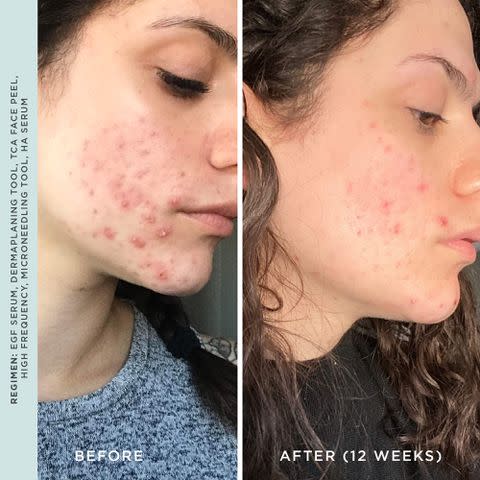Do High-Frequency Wands Work for Acne? Here's Everything YOu Need to Know

Stocksy
Reviewed by Lucy Chen, MD
Anyone who has ever dealt with acne knows that treatment isn't one-size-fits-all. There are dozens of skincare products, prescription medications, and in-office treatments that work to reduce all sorts of breakouts, but arguably none look as cool as high-frequency wands do. (Except perhaps LED therapy devices, but we're not here to talk about them right now.)
High-frequency wands look and sound high-tech, but the science behind them is quite simple. The treatment channels low-level electrical currents to each blemish it comes in contact with, and that current zaps acne-causing bacteria, decreases inflammation, improves circulation, and even helps decrease stubborn hyperpigmentation spots.
We tapped board-certified dermatologists, Rachel Nazarian and Nava Greenfield along with licensed esthetician, Kerry Benjamin, to ask them everything there is to know about high-frequency wands and in-office treatments. To understand the benefits of high-frequency treatments learn of the potential downsides and how to prep for using your high-tech wand, keep scrolling.
Meet the Experts
Rachel Nazarian, MD, is a board-certified dermatologist and fellow of the American Academy of Dermatology. She specializes in cosmetic treatments, skin cancer, and dermatologic surgery.
Kerry Benjamin is an L.A.-based esthetician and the founder and CEO of StackedSkincare.
Nava Greenfield, MD, a board-certified dermatologist of Schweiger Dermatology Group in New York City.
What Is a High-Frequency Wand Spot Treatment?
High frequency is a technique that utilizes targeted thermal energy to treat acne, fine lines, wrinkles, enlarged pores, cellulite, and undereye circles. "High frequency uses small currents to oxygenate the skin," explains Benjamin. Acne-causing bacteria's worst nightmare, oxygen kills the pimple-inducing stuff on contact. "There are two kinds of high-frequency electrodes; Argon gas and Neon gas," she continues, "Argon gas is violet and is great for acne/oily skin. Neon gas is for anti-aging benefits." So if you're looking to treat acne with high frequency, look for the Argon or violet variety.
Benefits of High-Frequency Wands as Spot Treatments for Acne
Clearly, this high-tech treatment has a slew of benefits. Once you use it, there are a bunch of improvements to look out for including:
Reduced acne-causing bacteria
Minimized inflammation and redness
Reduced post-inflammatory hyperpigmentation (PIH)
Smaller-looking pores
Oxygenated the skin
Reduced acne and prevents future breakouts
Increased circulation
While we have personally experienced impressive results in terms of reduced breakouts when using a high-frequency, be forewarned that some derms won't give it their stamp of approval just yet. High-frequency treatments are meant to kill bacteria and reduce inflammation, hence the apparent acne-fighting benefits. The remedies increase circulation to stimulate collagen, making the treatment an effective anti-aging and glow-boosting tool, too. But, according to Dr. Nazarian, "there are no specific studies that would suggest using [high frequency] to treat acne."
How to Prepare for a High-Frequency Spot Treatment
To prepare for an at-home high-frequency spot treatment, Benjamin says to always cleanse the skin before the facial. And she recommends applying a layer of serum "to penetrate deeper into the skin to speed up acne healing," she adds. You'll also need to stop using any retinoids for five to seven days before the treatment and avoid harsh exfoliants for a week prior.
Byrdie Tip
Be sure to remove any metal jewelry before your high-frequency treatment.
What to Expect During a High-Frequency Spot Treatment
In the past, you’d have to go to a spa to experience a high-frequency facial for acne, but there have been several at-home device launches that allow you to achieve spa-like results from the comfort of your own bathroom.
The tool itself looks like a stick with a little bubble on the end—that bubble is the electrode. The electrode produces argon gas and emits a small electrical current. When applied to the skin, Benjamin says it generates oxygen, kills bacteria, and calms inflamed skin for the high-frequency home facial of your dreams. The tool is a safe skin treatment for both cystic and active acne and works to shorten the lifespan of the breakout and prevent future blemishes and post-inflammatory hyperpigmentation.
StackedSkincare High Frequency Acne Device ($130)

To achieve the stellar results that a high frequency wand is known for, you must understand how to wield it properly. Benjamin explains how below.
Thoroughly wash and dry your face, and apply your serum. Benjamin suggests one with epidermal growth factors, like Nurse Jamie's EGF Platinum 3 Restorative Facial Elixir ($198), as growth factors speed up healing.
Cut a small piece of gauze, and place it on your face.
Insert the electrode into the wand, place it over the gauze, and turn it on.
Turn up the dial on the wand until you feel a slight tingling sensation. “You should feel it, but it should not be painful,” Benjamin says. “Don’t crank it on too high, or you will dry out the acne too much.”
Move the wand over the acne lesion in circular motions, working on each area for no more than three to five minutes. “You can also ‘spark’ the acne by tapping the tip of the wand on the acne a few times, and then move in a circular motion again,” Benjamin says.
Once you’ve hit all the spots, your high-frequency facial is officially over, and you can finish by applying your moisturizer.
Before and After a High Frequency Spot Treatment

Courtesy of StackedSkincare
Apart from visibly reduced breakouts, this StackedSkincare user saw significant improvement in acne and inflammation while using the High-Frequency Device in combination with the TCA Peel ($122).
High-Frequency Spot Treatment vs. LED Light Therapy
A similarly futuristic method of acne-treating technology is LED light therapy. Often confused with high frequency, we asked Benjamin to give us a run-down on what sets the two treatments apart.
"High frequency is a rejuvenation process based on electrical currents," Benjamin explains. "This treatment utilizes oscillation, or movement, through a wand attached to a compact machine. The electrical currents are set at just the right frequency. During a high-frequency treatment, low-level electricity is transferred to bulb-like tips through an easy-to-hold wand. The bulb is then placed just at the surface of the skin where the electrical magic takes place on your face."
While high frequency utilizes low-level electricity to penetrate deep into the skin, LED therapy harnesses the power of light to kill superficial bacteria on the skin in acne treatments. "LED stands for light-emitting diode (LED). The device emits specific wavelengths of light that provide a safe method of cell renewal," says Benjamin. "It’s a great way to treat a wide range of concerns, and it’s also almost impossible to overdo the treatment since these devices emit a very low wavelength." With LED therapy, blue light is used to treat acne, while red light is used for anti-aging benefits.
At-Home High Frequency Wands vs. In Office Treatments
Treatments performed at home will typically use a lower amount of energy and therefore, provide less dramatic results than in-office. "Devices in the office are frequently able to deliver a higher amount of energy," explains Dr. Greenfield. "They come with more risk and are only performed by trained individuals."
Potential Side Effects of High Frequency Wands
Thankfully, the side effects of high-frequency spot treatments are minimal. "Some may experience tingling, redness, swelling after the procedure, which generally resolves in up to a few days," says Dr. Greenfield. "It's a pretty well-tolerated procedure."
To prevent drying the skin out and exacerbating acne, avoid using any at-home high-frequency device for too long or on too high a setting. "Stick to no more than two to three minutes in any given area and 15-20 minutes for your whole face up to once a day," advises Benjamin.
If your skin is on the sensitive side, you could experience some inflammation. Benjamin does not recommend high-frequency for people with a pacemaker, a history of heart disease, or during pregnancy. "If you have sensitive skin conditions such as rosacea, eczema, or psoriasis, please avoid these areas if they are inflamed." Additionally, Benjamin cautions against using AHA or glycolic acid with high frequency and says to avoid any broken capillaries or spider veins.
Glycolic Acid
Glycolic acid is an alpha-hydroxy acid that loosens bonds between dead skin cells. It helps stimulate collagen production and acts as a humectant, attracting moisture to the skin.
The Cost of High Frequency Treatments
You can expect to pay anywhere between $150-$400 for a high-frequency spot treatment, depending on whether your treatments are done via a home high-frequency wand or in-office. However, with a home device, you can get multiple treatments out of the one payment, whereas with in-office reoccurring treatments, this price will add up over time.
Aftercare
There's minimal downtime with a high-frequency treatment, but Dr. Greenfield recommends being gentle with your skin on the day of the procedure, "You want to avoid anything harsh; no harsh cleansers," she says.
Benjamin suggests applying a layer of healing serum followed by a hyaluronic acid serum, then finishing with moisturizer after the treatment. For oily skin, she recommends a light water-based moisturizer.
The Final Takeaway
While I notice a significant difference in my skin when using high-frequency, note that using high-frequency specifically for breakouts is a bit controversial. Some estheticians and dermatologists back the treatment for breakouts, but there haven't been many scientific studies to prove the treatment's effectiveness. You may want to consult your dermatologist before getting a high-frequency device to treat any form of acne, especially if you plan to use an at-home tool.
Up Next: The 8 Best Acne Treatments of 2024
Read the original article on Byrdie.

